As we celebrate the New Year, we commemorate the passage of the old. In the mass media, this comes in the form of top ten lists and “in memoriam” montages. In folk imagery, it is symbolized by Father Time with his sickle—he even appears in Rudolph’s Shiny New Year. Though often comical in recent depictions, Father Time is nevertheless a memento mori—a remembrance of death—and he reminds us of an even older tradition.
 Father Time / via reelrundown.com
Father Time / via reelrundown.com
The memento mori or vanitas (i.e., the vanity of earthly pleasures) image has long been a staple of Western art. It originated as a tombstone ornament, often featuring skulls, hourglasses, scythes, and weeping willows; these can still be found in old churches and graveyards across North America and Europe.
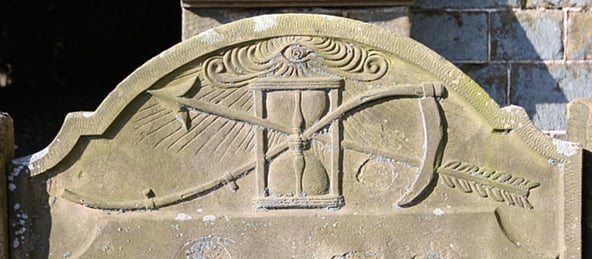 Scythe and Hourglass / via cityofgroveok.gov
Scythe and Hourglass / via cityofgroveok.gov
The Vanitas in Modern Art
In the Baroque period, when the portable, framed picture became ubiquitous, the vanitas image migrated into devout homes, usually in the form of still life painted on canvas. Among luxury goods such as Chinese porcelain, rock-cut crystal, and sterling silver, a skull or wilting flower would peek out, reminding viewers of the feebleness of pleasure and the ravages of time.
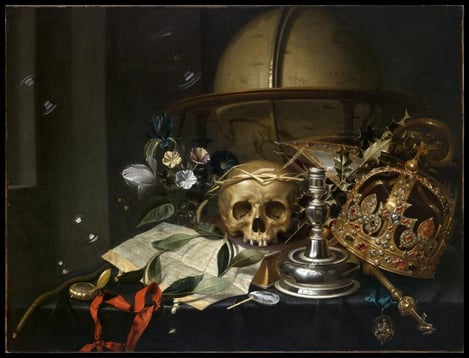 Vanitas Still Life by Hendrick Andriessen / via artmuseum.mtholyoke.edu
Vanitas Still Life by Hendrick Andriessen / via artmuseum.mtholyoke.edu
Indeed, the memento mori or vanitas still life remains a potent touchstone for modern and contemporary artists. The feminist artist Audrey Flack updated the traditional form with twentieth-century pop-culture imagery. The autobiographical skeletal figures of Jean-Michel Basquiat combined the vanitas tradition with self-portraiture. Most recently, the Indonesian artist Agus Suwage has made a vanitas assemblage of a skull, Disney mouse ears, and a crown.
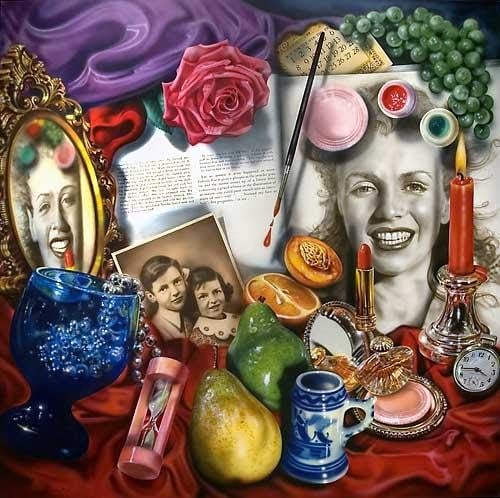 Audrey Flack's Marylyn / via artmuseum.arizona.edu
Audrey Flack's Marylyn / via artmuseum.arizona.edu
Perhaps the quintessential vanitas or memento mori is the 1671 Vanitas Still Life of Philippe de Champaigne. It is a favorite of bloggers and other online commentators because of its sober simplicity and iconic power. It confronts the viewer bluntly with the potent basics of the genre: a tulip, slightly wilting; a gazing, plaintive skull; and an hourglass, with all its entropic poetry.
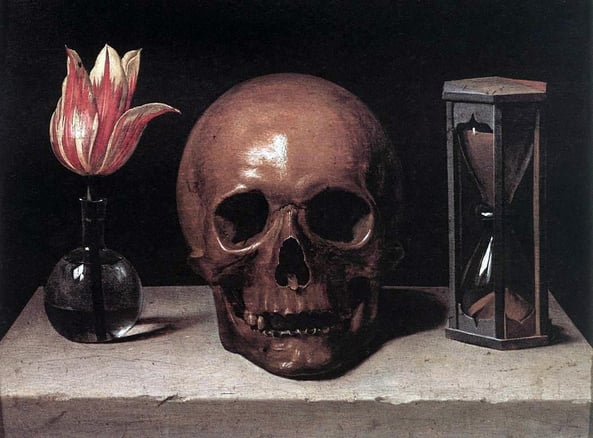 Philippe de Champaigne, Public domain / via Wikimedia Commons
Philippe de Champaigne, Public domain / via Wikimedia Commons
The Hourglass
The hourglass. It has connotations of incremental, irrevocable loss. It appears in many vanitas images and, indeed, almost defines the genre. Its message is one of emptiness: in Adriaen Coorte’s Baroque-era vanitas, the sand in the bottom is hidden by a skull as if it had vanished into a shadowy afterlife. In a popular surrealist version, the glass’s bottom chamber is broken, and the sand leaks out into nothingness. In both cases, the loss of both matter and time seems complete.
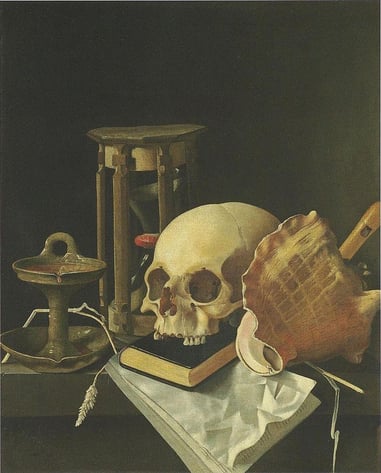 Adriaen Coorte, Public domain / via Wikimedia Commons
Adriaen Coorte, Public domain / via Wikimedia Commons
But in reality, of course, the sand in an hourglass is not lost; the glittering, particulate flow is always ready to descend again. At this time of annual beginnings, following closely Christ’s natal Beginning, the hourglass strikes me with a different meaning: it is a metaphor for all of history.
Our Glimmering Hourglass God
The top of the glass is the time before—before Christ’s sweet condescension—when the heft of our great God pressed crushingly down. In ancient times, He seemed much too big for us, though His love was vast, and His heart bled. We knew Him as a bringer of plagues or a fiery pillar. We could not comprehend His subtlety and His gentleness.
And so He became incarnate. He constricted and limited himself, passing through the narrows of mortal form, taking on the shape of a servant. He did not aspire to the grandeur and fullness that was His right.
The angels were dumbfounded by His reckless vulnerability. But it was by this means that His glory could be revealed again, incrementally, in a manner proportionate to our smallness. And this glory is still being revealed in an unfolding drama of great suspense, virtuosity, and surprise.
So it is that God’s self-revelation is like the sand in an hourglass. It comes from on high and shrinks itself, that it might accumulate again “at our level.” And not only that but it is compounded through our bodies. We are each a grain of sand in the immensity of God’s glory, by the grace of His incarnation, aggregating His Kingdom together under Jesus our Head.
We are fragments of His gradual unfolding, that dear Heart of total self-giving, each revealing new parts of His character, comprising the trickle of our Beloved into time.
Praise be to the Lord of death and time and bloom and seep and rebirth.
The demons of static perfection, judgmental and inert, have nothing on our glimmering hourglass God.
*Originally published January 5, 2022.

